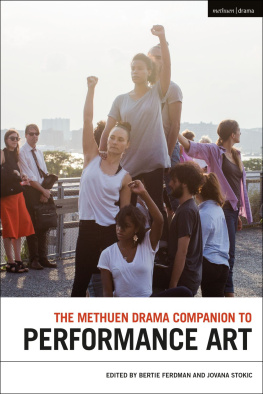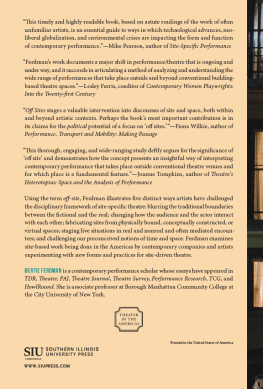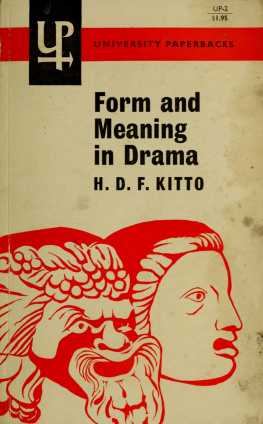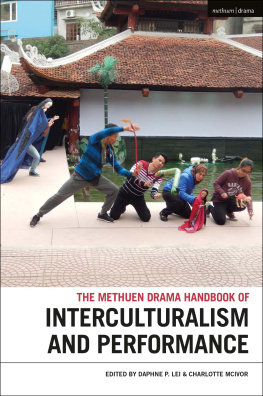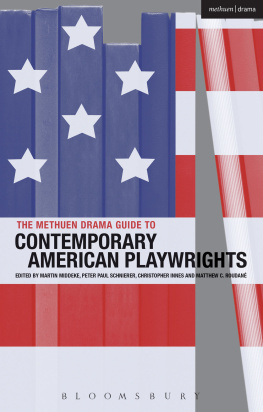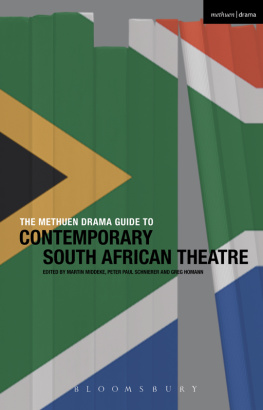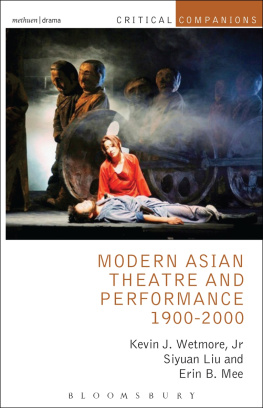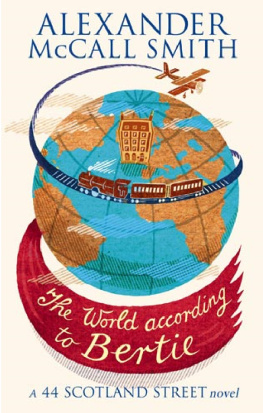Bertie Ferdman - The Methuen Drama Companion to Performance Art
Here you can read online Bertie Ferdman - The Methuen Drama Companion to Performance Art full text of the book (entire story) in english for free. Download pdf and epub, get meaning, cover and reviews about this ebook. publisher: Bloomsbury UK, genre: Art. Description of the work, (preface) as well as reviews are available. Best literature library LitArk.com created for fans of good reading and offers a wide selection of genres:
Romance novel
Science fiction
Adventure
Detective
Science
History
Home and family
Prose
Art
Politics
Computer
Non-fiction
Religion
Business
Children
Humor
Choose a favorite category and find really read worthwhile books. Enjoy immersion in the world of imagination, feel the emotions of the characters or learn something new for yourself, make an fascinating discovery.
- Book:The Methuen Drama Companion to Performance Art
- Author:
- Publisher:Bloomsbury UK
- Genre:
- Rating:3 / 5
- Favourites:Add to favourites
- Your mark:
- 60
- 1
- 2
- 3
- 4
- 5
The Methuen Drama Companion to Performance Art: summary, description and annotation
We offer to read an annotation, description, summary or preface (depends on what the author of the book "The Methuen Drama Companion to Performance Art" wrote himself). If you haven't found the necessary information about the book — write in the comments, we will try to find it.
The Methuen Drama Companion to Performance Art — read online for free the complete book (whole text) full work
Below is the text of the book, divided by pages. System saving the place of the last page read, allows you to conveniently read the book "The Methuen Drama Companion to Performance Art" online for free, without having to search again every time where you left off. Put a bookmark, and you can go to the page where you finished reading at any time.
Font size:
Interval:
Bookmark:

The Methuen
Drama Companion to
Performance Art
Methuen Drama Handbooks is a series of single-volume reference works which map the parameters of a discipline or sub-discipline and present the state-of-the-art in terms of research. Each Handbook and Companion offers a systematic and structured range of specially commissioned essays reflecting on the history, methodologies, research methods, current debates and future of a particular field of research. Methuen Drama Handbooks provide researchers and graduate students with both cutting-edge perspectives on perennial questions and authoritative overviews of the history of research.
The Bloomsbury Companion to Dance Studies
edited by Sherril Dodds
ISBN 978-1-350-02446-5
The Methuen Drama Handbook of Theatre History and Historiography
edited by Claire Cochrane and Jo Robinson
ISBN 978-1-3500-3429-7
Forthcoming
The Methuen Drama Handbook of Gender and Theatre
edited by Sean Metzger and Roberta Mock
ISBN 978-1-3501-2317-5
The Methuen Drama Handbook of Interculturalism and Performance
edited by Daphne P. Lei and Charlotte McIvor
ISBN 978-1-3500-4047-2
The Methuen
Drama Companion to
Performance Art
Edited by
Bertie Ferdman and Jovana Stokic

Contents
Bertie Ferdman and Jovana Stokic
Jovana Stokic
Bertie Ferdman
Heike Roms
Amelia Jones
Rebecca Schneider
Thomas F. DeFrantz
Peter Eckersall
Malik Gaines
T. Nikki Cesare Schotzko
Bojana Kunst
Sven Ltticken
Danielle Bainbridge
Cecilia Fajardo-Hill
Lois Keidan
Jonah Westerman and Catherine Wood
Chris Salter
Eyll Fidan Aknc
| George Maciunas, Fluxus (Its Historical Development and Relationship to Avant-garde Movements) , c. 1966 |
| Wolf Vostell, Pre-Fluxus New York Avant 1962; Pre-Fluxus Cologne Avant 1962; Fluxus Wiesbaden 1962 (n.d.) |
| Nam June Paik, Fluxus Island in Dcollage Ocean , 1963 |
| Mieko Shiomi, Spatial Poem No. 2 , 1966 |
| Fayette Hauser, photograph of the Cockettes performing, 1970 |
| Nao Bustamante, Indigurrito , 1992 |
| Zackary Drucker, The Inability to be Looked at and the Horror of Nothing to See , 20089 |
| Emilio Rojas, Instructions for Becoming (Indio Desnudo) , 2019 |
| Emilio Rojas, Heridas Abiertas (A Gloria) |
| Rebecca Belmore, Fringe , 2008 |
| Soldiers Arch, Brown University |
| Leroy Eldridge in Mont Noelle Marshalls Buy My Soul and Call It Art |
| Shireen Dickson in reVERSE-gesture-reVIEW |
| Complexity of Belonging |
| Else Tunmeyr, When We were Weary/The Loneliest Whale in the World , 2017 |
| Catalina Insignares, us as a useless duet , 2017 |
| An early Laban pupil demonstrating a well-shaped body in expressive position, combined with an effort graph |
| Alexandra Pirici, Aggregate (2017), at NBK |
| Albert Chong, Natural Mystic, 1982 |
| Patssi Valdez, Limitations beyond My Control , 1975 |
| Cecilia Vicua, El Zen Surado , 1960s2013, collage |
| Maria Evelia Marmolejo, 11 de marzo , 1981 |
| La Pocha Nostra, Ex-Centris (A Living Diorama of Fetish-ized Others) , Live Culture, 2003 |
| La Ribot, Panoramix , Live Culture, 2003 |
| Sybille Peters, KAPUTT , 2017 |
| Liberate Tate, Human Cost , 2011 |
| Carlos Amorales, Amorales vs. Amorales, 2003 |
| Tania Bruguera, Tatlins Whisper #5, 2008, performed as part of UBS Openings: LiveThe Living Currency |
| Boris Charmatz, Public Warm Up at Tate Modern, 2015, part of BMW Tate Live: If Tate Modern Was Muse de la danse? |
| Chris Salter and TeZ, Haptic Field , 2017 |
| Kurt Hentschlager, Feed.X , 2018 |
We would like to thank Amelia Jones for sending this project in our direction and to all the authors who contributed so much of their time and effort to this volume: Eyll Fidan Aknc, Danielle Bainbridge, T. Nikki Cesare Schotzko, Thomas F. DeFrantz, Peter Eckersall, Cecilia Fajardo-Hill, Malik Gaines, Amelia Jones, Lois Keidan, Bojana Kunst, Sven Ltticken, Heike Roms, Rebecca Schneider, Chris Salter, Jonah Westerman, and Catherine Wood. We would also like to thank Claire Bishop and Ana Janevski who, in the initial stages of this book, recommended sources and contributors. We are extremely grateful to friends and colleagues who gave us support, feedback, and conversation throughout this process: Peter Eckersall, Naomi Lev, Jill Samuels, Erika Latta, and Andrew Weiner. Exchanges with the following artists were especially inspiring: Anna Ostoya, Irena Haiduk, and Alexandra Pirici, as well as panels about the book held at the following conferences: IFTR Belgrade, CAA New York, and PSi Calgary. In particular, Jovana would like to thank her students from the MFA Art Practice at the School of Visual Arts. All these aforementioned exchanges helped us to shape our understanding of the field of performance in art contexts today.
We would also like to thank Mark Dudgeon and Lara Bateman at Methuen Drama for their invaluable help throughout all the stages of this project, as well as the peer reviewer whose thorough feedback fostered productive revisions.
Finally, to our families and life partners, without whom this book would not have been possible. Franck Lesbros: you are the vita activa to my vita contemplativa. Julien Jourdes: tu es mon amour, ma vie. Paloma y Talia: siempre sern las luces de mi vida.
Bertie Ferdman and Jovana Stokic
ISetting the Stage
Swedish director Ruben stlunds film The Square , winner of the 2017 Palme dOr at the Cannes Film Festival, includes a stunning scene that features performance art in all its glory. In it, we witness a fancy fundraiser gala dinner for a contemporary art museum go awry by the presence, or shall we say performance, of an artist named Oleg, inspired by the notorious Ukrainian-born Russian performance artist Oleg Kulik. Played by actor and movement coach Terry Notary, of Planet of the Apes fame, the bare-chested Oleg goes too far in his impersonation of an ape. Notary is an extraordinarily skilled performer and compellingly virtuosic as Oleg. What starts out as a seemingly inoffensive and almost amusing ape reenactment gradually turns askew as Oleg grows in intensity as an increasingly wild and untamable animal. His gestures grow large and his screams even louder. He growls at the well-dressed diners, singles them out, throws chairs around, smashes a wine glass and forces some guests out of the room. The tension mounts as he knuckle-walks his way, eyeing his next prey. Completely transformed as ape-man, he pounds his chest, mounts a table, and slowly begins to caress and eventually grabs a woman by her long blonde hair. He drags her across the floor, forces her down, pulls up her skirt, and violently mounts her. She audibly wails and shrieks for help. After what seems like too long of a wait, an older man rushes to save her, eventually another arrives, and then all the well-dressed men in suits appear, taking turns bashing Oleg to the ground.
The scene, meant to make the mostly wealthy art patrons uncomfortable and test the limits between spectacle versus danger, plays with the inability to distinguish art from what is real, which we might say of performance art itself. But the scene also seems to replicate the conditions under which much of performance art is consumed today in first world countries: in fancy banquets, as a form of social standing, as philanthropic tax breaks for the rich, as a pretense of subversion hidden under the veil of a potential economic profit margin. The scene is a dramatic rendering of performance art: scripted, acted, and edited for a movie. It was filmed under somewhat particular circumstancesthe almost 300 film extras in the room were not pretending to be art patrons, but were actual millionaire donors, gallery owners, artists, and wealthy art scene personalitiesto maintain a sense of uncertainty and authenticity (unrehearsed reactions) from the gala guests, as well as from Notary himself (
Font size:
Interval:
Bookmark:
Similar books «The Methuen Drama Companion to Performance Art»
Look at similar books to The Methuen Drama Companion to Performance Art. We have selected literature similar in name and meaning in the hope of providing readers with more options to find new, interesting, not yet read works.
Discussion, reviews of the book The Methuen Drama Companion to Performance Art and just readers' own opinions. Leave your comments, write what you think about the work, its meaning or the main characters. Specify what exactly you liked and what you didn't like, and why you think so.

